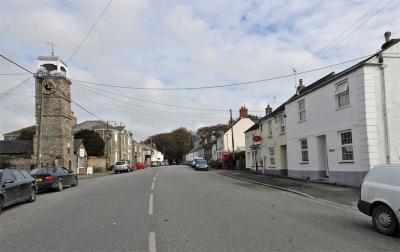


The gateway to the Roseland Peninsula
Web: www.facebook.com/groups/386588451997511
Tregony is a village which is situated in the middle of the county of Cornwall, between the towns of Truro and St. Austell on the B3287. It is located in a delightful, country area on the approach to the Roseland Peninsula. Tregony was once known as a 'Town' hence the width of the road through the village and it was an important centre of its time. The place has a long history reaching back to pre Norman times. Today it has reverted back to being a pleasant small, rural community. It lies on the River Fal and Tregony Bridge carries the A3078 road. In the village there is a post office (now closed and located in the shop), shop, and two churches. Tregony has bus links to the nearest town, which is Truro. Cornelly parish was united with Tregony in 1934. Tregony was once a port, but the river silted up due to tin streaming and china clay processing upstream at St. Stephen. For a while enterprising locals took advantage of this and silt dredged from the river was used to make bricks in a factory at nearby Ruan Lanihorne. The population of the village was 853 at the 2011 census.
The manor of Tregony was recorded in the Domesday Book of 1086 when it was held by Frawin from Robert, Count of Mortain. Its earliest known spelling was Trefhrigoni, in 1049.
Queen Elizabeth I granted the privilege of reviving Tregony's ancient right to send two burgesses to parliament. Two members of Parliament were so elected at each of the general elections up until 1832 when the Borough was disenfranchised.
In the 1820's a private, fee paying, boys boarding school (Hart House School) was opened at Tregony by Dr James Hart who was also a Minister at the local Congregational Chapel. The school, which was one of the largest in Cornwall, stayed in existence until 1893 when it was destroyed by fire. It never re-opened. Pupils from all parts of the Country, and even from abroad, attended the school during the time it was open.
Tregony's geographical location was the prime reason for its historical importance. Its position on the higher reaches of the River Fal, some fifteen miles from the sea, made it a very important and strategic inland port, when the river was tidal and navigable. It has been suggested that the Phoenician and Roman traders sailed here and went even further up river in search of tin.
Tregony is noted for it's exceptionally wide main street and for the Clock Tower, built in 1833 out of Pentewan stone.
The Church of St. James at Tregony was founded in the 11th century but in the early 16th century it was abandoned as it had been submerged by the tidal river. (This was caused by the building of Tregony Bridge ca. 1300 which led to the accumulation of alluvial deposits on the riverbed.) The church valuables were removed to Cuby Church sometime between 1530 and 1553: for many years thereafter the building was quarried for stone and no remains were to be seen by the early 20th century. The church had been founded by the Norman family of Pomeroy whose castle stood here: nearby there were also in mediaeval times a priory and a chapel of St. Anne. There are no remains of any of these buildings either. Since the parish lost its church, the parishioners have used Cuby Church instead. The other active church in Tregony is one of the few remaining independent Congregational churches—those that did not become part of the United Reformed Church. The former Methodist Church still has a small wooden sign on it but is now a private home. The almshouses were built in 1696 by Hugh Boscawen and re-built in 1895.
It has a primary school in Back Lane. The area's secondary school, The Roseland Community College built in 1962, is just over the Parish of Tregony boundary and has recently had a brand new sports hall. It has also achieved specialist school status in Music with English and IT.
The parish of Cornelly near Tregony has a church but no village: it is now grouped with Tregony and Cuby. Cornelly church is dedicated to St Cornelius and was built in the 13th century: the upper part of the tower, the south porch and the windows of the south wall are 15th century additions. The font is probably 16th century but of very crudely carved granite; the pulpit is painted with coats of arms; a monument to Jane Reeves, 1783, has an excellent portrait bust of her.
William Gregor (1761-1816). A geologist-clergyman who lived on The Trewarthenick Estate in the hamlet of Trewarthenick in Cornelly parish, later discovered titanium in 1791.
Richard Gurney (1790–1843). An English judge in the Stannary Courts of Devon. His corrupt practices were exposed during the trial of Mary Ann Tocker in 1818. Following the trial, he wrote a pamphlet expounding the Law of Libel at the time and attempting to defend his actions.
Thompson Gurney (1820-1887). Anglican churchman Archer from Tregony
Captain William Hennah RN (1768-1832), who took part in the Battle of Trafalgar before retiring to Tregony.
Mary Ann Tocker (1778–1853), from Tregony was the first woman in Cornwall to be tried for Libel and was celebrated as the first woman to act as her own advocate in a British court of law. She has been referred to as the first woman lawyer.
Tregony Heavy Horse Show and Country Fayre - Mid August.
Christmas Lights Switch-On - Mid December.
Grampound St. Austell Truro Creed House and Garden Trewithen House and Gardens
Probus The Roseland Peninsula Grampound Heritage Centre St. Ewe